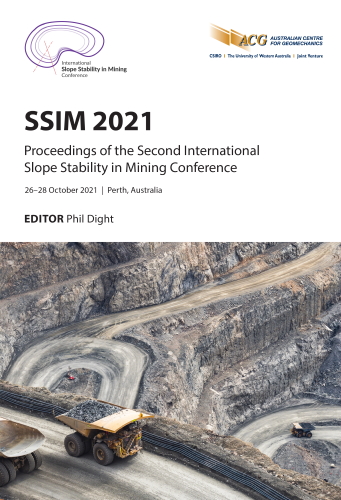Case study: open pit three-dimensional slope stability back-analysis for an anisotropic iron ore rock mass

|
Authors: Figueiredo, L; Barros, M; Hammah, R; Santos, Y; Souza, T; Nogueira, C |
DOI https://doi.org/10.36487/ACG_repo/2135_04
Cite As:
Figueiredo, L, Barros, M, Hammah, R, Santos, Y, Souza, T & Nogueira, C 2021, 'Case study: open pit three-dimensional slope stability back-analysis for an anisotropic iron ore rock mass', in PM Dight (ed.), SSIM 2021: Second International Slope Stability in Mining, Australian Centre for Geomechanics, Perth, pp. 107-120, https://doi.org/10.36487/ACG_repo/2135_04
Abstract:
The challenges of representing geotechnical failure mechanisms in software is being gradually addressed as search algorithms and computing power advance, especially to deal with complex anisotropic rock masses in which failure mechanisms are commonly three-dimensional (3D). This paper presents a case study of an iron ore mine with highly anisotropic rock mass strength that has been back-analysed using 3D limit equilibrium analysis methods. In order to provide as realistic model inputs as possible, field characterisation data and the reconstruction of the failed surface were used, as well as the material properties available from laboratory tests or bibliographic references. A probabilistic approach was applied to the initial parameters, resulting in a series of stochastic simulations that provided scenarios for the failure moment, when the Factor of Safety achieved close to 1.0. Then, based on the knowledge of the local geological-geotechnical context and failure mechanisms, a range of values for the geomechanical parameters were achieved to enhance the constitutive model of the rock mass.
Keywords: three-dimensional limit equilibrium, open pit slope stability, anisotropic iron rock masses, backanalysis
References:
Assis, AP 2020, ‘Risk management for geotechnical structures: consolidating theory into practice’, Soils and Rocks, vol. 43, no. 3, pp. 311–336.
Barton, NR & Bandis, S 1983, ‘Effects of block size on the shear behaviour of jointed rock issues in rock mechanics’, Proceedings of the 23rd US Symposium on Rock Mechanics, Society of Mining Engineers of AIMS, Berkeley, pp. 739–760.
Barton, NR & Bandis, S 1990, ‘Review of predictive capabilities of JRC-JCS model in engineering practice’, in N Barton & O Stephansson (eds), Proceedings of the International Symposium of Rock Joints, AA Balkema, Rotterdam, pp. 603–610.
Barton, N & Choubey, V 1977, ‘The shear strength of rock joints in theory and practice’, Rock Mechanics, pp. 10, no. 1, pp. 1–54.
Dershowitz, WS, Finnila, A, Rogers, S, Hamdi, P & Moffitt, KM 2017, ‘Step path rock bridge percentage for analysis of slope stability’, Proceedings of the 51st US Rock Mechanics/Geomechanics Symposium, American Rock Mechanics Association, Alexandria.
Horn, HM & Deere, DU 1962, ‘Frictional characteristics of minerals’, Géotechnique, vol. 12, no. 4, pp. 319–335.
Jennings, JE 1972, ‘An approach to the stability of rock slopes based on the theory of limiting equilibrium with a material exhibiting anisotropic shear strength’, Proceedings of Stability of Rock Slopes, American Society of Civil Engineers, New York,
pp. 269–302.
Mitchell, JK & Soga, K 2005, Fundamentals of Soil Behavior, vol. 3, John Wiley & Sons, New York.
Rocscience Inc. 2021, Slide 3, computer software, Rocscience Inc., Vancouver.
© Copyright 2025, Australian Centre for Geomechanics (ACG), The University of Western Australia. All rights reserved.
View copyright/legal information
Please direct any queries or error reports to repository-acg@uwa.edu.au
View copyright/legal information
Please direct any queries or error reports to repository-acg@uwa.edu.au